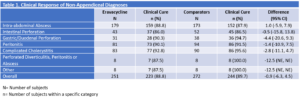Efficacy of Eravacycline in Non-Appendiceal Complicated Intra-Abdominal Infections: An Analysis of Two Phase 3 Trials
Author(s):
Vanessa Grant-DiFelice; Larry Tsai; Joseph Solomkin; Sergey Izmailyan
Background:
In clinical practice, complicated intra-abdominal infections (cIAI) are a significant cause of morbidity and mortality. Compared to complicated appendicitis, cIAIs of non-appendiceal etiology carry a higher risk for initial treatment failure, prolonged treatment duration and increased mortality.
Eravacycline (ERV) is a fully-synthetic fluorocycline antibiotic approved by the FDA and EMA for the treatment of cIAI in adults. It has broad in vitro activity against Gram-negative, Gram-positive and anaerobic pathogens. In two Phase 3 clinical trials, eravacycline demonstrated non-inferiority to carbapenems in patients with cIAI. The objective of this post-hoc analysis was to compare clinical outcomes in non-appendiceal subgroups from these trials.
Hypothesis:
Patients with non-appendiceal cIAI treated with eravacycline have similar clinical outcomes compared to carbapenems.
Methods:
IGNITE1 and IGNITE4 were randomized, doubled-blinded, multicenter, prospective non-inferiority phase 3 trials that evaluated the efficacy and safety of eravacycline vs ertapenem and meropenem, respectively, for the treatment of cIAI. Clinical response at the test of cure (TOC) visit was the primary efficacy endpoint in the micro-ITT population. A post-hoc analysis of patients diagnosed with cIAI of non-appendiceal origin was performed to determine comparative clinical outcomes.
Results:
In the micro-ITT population, 415 patients received eravacycline and 431 patients received comparator therapy. Clinical cure rates in patients diagnosed with complicated appendicitis were 89.0% and 88.6% in ERV and comparators respectively; in those with non-appendicitis, rates were 88.8% and 89.7% respectively. Across the non-appendiceal subgroups, clinical outcomes between ERV and comparators were similar (Table 1).

Conclusions:
Overall, clinical cure rates observed in eravacycline and carbapenem comparators were similar among the patients diagnosed with non-appendiceal cIAI. This pooled analysis suggests that eravacycline is an effective empiric treatment option for cIAI, especially in those at greater risk for treatment failure.
